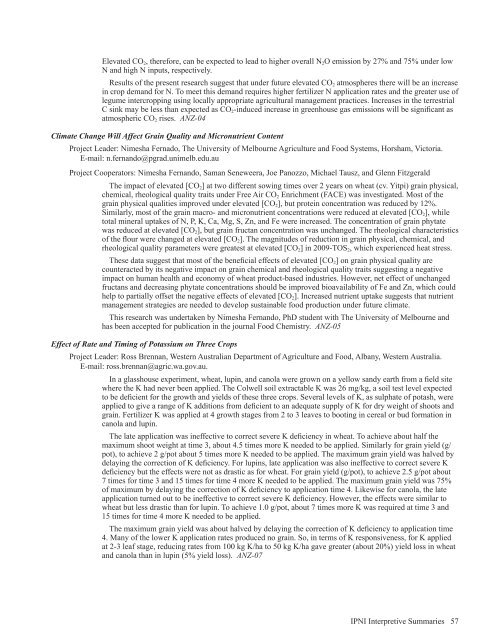Americas and Oceania Group - International Plant Nutrition Institute
Americas and Oceania Group - International Plant Nutrition Institute
Americas and Oceania Group - International Plant Nutrition Institute
You also want an ePaper? Increase the reach of your titles
YUMPU automatically turns print PDFs into web optimized ePapers that Google loves.
Elevated CO 2 , therefore, can be expected to lead to higher overall N 2 O emission by 27% <strong>and</strong> 75% under low<br />
N <strong>and</strong> high N inputs, respectively.<br />
Results of the present research suggest that under future elevated CO 2 atmospheres there will be an increase<br />
in crop dem<strong>and</strong> for N. To meet this dem<strong>and</strong> requires higher fertilizer N application rates <strong>and</strong> the greater use of<br />
legume intercropping using locally appropriate agricultural management practices. Increases in the terrestrial<br />
C sink may be less than expected as CO 2 -induced increase in greenhouse gas emissions will be significant as<br />
atmospheric CO 2 rises. ANZ-04<br />
Climate Change Will Affect Grain Quality <strong>and</strong> Micronutrient Content<br />
Project Leader: Nimesha Fernado, The University of Melbourne Agriculture <strong>and</strong> Food Systems, Horsham, Victoria.<br />
E-mail: n.fern<strong>and</strong>o@pgrad.unimelb.edu.au<br />
Project Cooperators: Nimesha Fern<strong>and</strong>o, Saman Seneweera, Joe Panozzo, Michael Tausz, <strong>and</strong> Glenn Fitzgerald<br />
The impact of elevated [CO 2 ] at two different sowing times over 2 years on wheat (cv. Yitpi) grain physical,<br />
chemical, rheological quality traits under Free Air CO 2 Enrichment (FACE) was investigated. Most of the<br />
grain physical qualities improved under elevated [CO 2 ], but protein concentration was reduced by 12%.<br />
Similarly, most of the grain macro- <strong>and</strong> micronutrient concentrations were reduced at elevated [CO 2 ], while<br />
total mineral uptakes of N, P, K, Ca, Mg, S, Zn, <strong>and</strong> Fe were increased. The concentration of grain phytate<br />
was reduced at elevated [CO 2 ], but grain fructan concentration was unchanged. The rheological characteristics<br />
of the flour were changed at elevated [CO 2 ]. The magnitudes of reduction in grain physical, chemical, <strong>and</strong><br />
rheological quality parameters were greatest at elevated [CO 2 ] in 2009-TOS 2 , which experienced heat stress.<br />
These data suggest that most of the beneficial effects of elevated [CO 2 ] on grain physical quality are<br />
counteracted by its negative impact on grain chemical <strong>and</strong> rheological quality traits suggesting a negative<br />
impact on human health <strong>and</strong> economy of wheat product-based industries. However, net effect of unchanged<br />
fructans <strong>and</strong> decreasing phytate concentrations should be improved bioavailability of Fe <strong>and</strong> Zn, which could<br />
help to partially offset the negative effects of elevated [CO 2 ]. Increased nutrient uptake suggests that nutrient<br />
management strategies are needed to develop sustainable food production under future climate.<br />
This research was undertaken by Nimesha Fern<strong>and</strong>o, PhD student with The University of Melbourne <strong>and</strong><br />
has been accepted for publication in the journal Food Chemistry. ANZ-05<br />
Effect of Rate <strong>and</strong> Timing of Potassium on Three Crops<br />
Project Leader: Ross Brennan, Western Australian Department of Agriculture <strong>and</strong> Food, Albany, Western Australia.<br />
E-mail: ross.brennan@agric.wa.gov.au.<br />
In a glasshouse experiment, wheat, lupin, <strong>and</strong> canola were grown on a yellow s<strong>and</strong>y earth from a field site<br />
where the K had never been applied. The Colwell soil extractable K was 26 mg/kg, a soil test level expected<br />
to be deficient for the growth <strong>and</strong> yields of these three crops. Several levels of K, as sulphate of potash, were<br />
applied to give a range of K additions from deficient to an adequate supply of K for dry weight of shoots <strong>and</strong><br />
grain. Fertilizer K was applied at 4 growth stages from 2 to 3 leaves to booting in cereal or bud formation in<br />
canola <strong>and</strong> lupin.<br />
The late application was ineffective to correct severe K deficiency in wheat. To achieve about half the<br />
maximum shoot weight at time 3, about 4.5 times more K needed to be applied. Similarly for grain yield (g/<br />
pot), to achieve 2 g/pot about 5 times more K needed to be applied. The maximum grain yield was halved by<br />
delaying the correction of K deficiency. For lupins, late application was also ineffective to correct severe K<br />
deficiency but the effects were not as drastic as for wheat. For grain yield (g/pot), to achieve 2.5 g/pot about<br />
7 times for time 3 <strong>and</strong> 15 times for time 4 more K needed to be applied. The maximum grain yield was 75%<br />
of maximum by delaying the correction of K deficiency to application time 4. Likewise for canola, the late<br />
application turned out to be ineffective to correct severe K deficiency. However, the effects were similar to<br />
wheat but less drastic than for lupin. To achieve 1.0 g/pot, about 7 times more K was required at time 3 <strong>and</strong><br />
15 times for time 4 more K needed to be applied.<br />
The maximum grain yield was about halved by delaying the correction of K deficiency to application time<br />
4. Many of the lower K application rates produced no grain. So, in terms of K responsiveness, for K applied<br />
at 2-3 leaf stage, reducing rates from 100 kg K/ha to 50 kg K/ha gave greater (about 20%) yield loss in wheat<br />
<strong>and</strong> canola than in lupin (5% yield loss). ANZ-07<br />
IPNI Interpretive Summaries 57

















